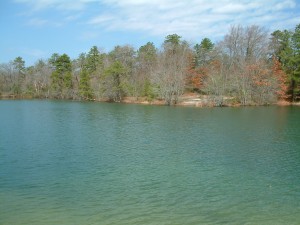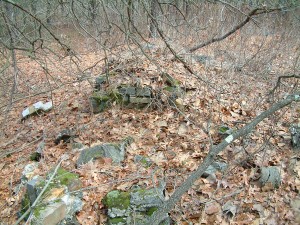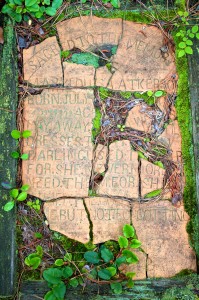Clay was king at Pasadena. Nestled back in the woods near Woodmansie, down the tracks from Whiting and even farther from Chatsworth, an empire of clay was borne and then quickly died. Wheatlands or Pasadena – the largest and most well known of these towns – still leaves her mark on the modern world by her ruins that, despite having been abandoned for nearly one hundred years, still look surprisingly good. The towns of Old Half Way, Union Clay Works, and Red Oak Grove however, are all but forgotten – simply empty clearings along the side of a seldom traveled dirt road.

The trail begins where Savoy Boulevard ends and Pasadena Road begins. The long abandoned Jersey Central Railroad tracks cross the road near the hamlet of Bullock, and a lone sign signals that you’ve entered Manchester Township. The dirt road leads down into Greenwood Wildlife Management Area, along what is known to the local hunters as the rye-strips – cleared land along the road set aside for deer to graze on. It was here that fox hunter Donald Pomeroy had his funeral service. We speed quickly past, taking the first right hand turn and plunging into the woods.
Today my friend and fellow NJPineBarrens.com poster Guy (Teegate) is with me. The trail isn’t as bad as we had thought. The snow and standing water that I had encountered three weeks before were gone, and all that remained were the ruts in the road from when people drove past when the trail was still snow covered, and the dark gray color of the sand that wasn’t yet dry. We make another right at an intersection where someone has carelessly left a blue drink cooler and come up to a sign prohibiting motor vehicles. From here we continue on foot.

Old Half Way, also known as Hidden Lakes, once was a town in the wilderness of Burlington County. There was a large clay mining enterprise nearby that eventually took over the town, dug it up, and left two very large pits. Left to time, the area reverted back to nature, the pits filling with water that was tinted aquamarine by the clay in the sand. The only small signs that there ever was civilization here are bits of scattered concrete from the foundations of buildings long lost. We walked to the first lake that ended up being deeper than usual, filling with the massive amount of rainwater and melted snow that we had this winter. We hiked to the second lake and found it even more impressive than the first. Here the lake is surrounded on all sides by very steep hills, making it harder for a vehicle to get to the waters edge. In fact the only vehicles we saw here were ones that had a one-way trip. Cars stolen, stripped, and burnt and left in the wilderness forever. One of these cars was even in the lake itself!
Over the years, Old Half Way became known as a party spot and on any given weekend there could be hundreds of people partying. The area was frequented by four wheelers that drove carelessly in and out of the lake. The result was that much of the land near the first lake had eroded and is very loose and unstable. It would be very easy to get stuck coming in and out of the lake area.
Our travels brought us to Union Clay Works. It’s rumored that the works suffered an outbreak of smallpox that wiped out a large portion of the population in the area. That, coupled with the difficulty of getting clay from the pits to the kilns, and finished products from the kilns to the narrow gauge railroad that connected at Woodmansie spelt disaster for the works. Details are sketchy of when the works were in operation but I believe it was around the years of 1875-1900.
Like many other forgotten towns in the Pine Barrens, the location of the site of Union Clay Works is betrayed by the unmistakable sign of man that has manipulated the environment around him. Two large clearings and a fallen Catalpa Tree, non-native to the Pine Barrens, show that this was the site of the town. Several cellar holes, some brick, and broken pieces of terra cotta are all that is left of this town. We had been told that there were the ruins of several kilns, with discarded pieces of terra cotta pipe to be found, but we only found one ruin that looked like it could have been a kiln. It seemed too small to have been used for making large pipes, however. Union Clay Works still keeps some of her secrets hidden.
Henry Charlton Beck, the famed historian, visited this area in the 1930s after being told of a small graveyard lost in the woods. Guy and I had been determined to find it for several months. Like Beck, we had both made trips into the area without much success. Becks directions were purposely vague and not much help. We eventually did find it, by accident, and we can see why Beck was confused. The graves are small and only visible once you’re almost on top of them. They are in very poor shape, and the presence of too many curious visitors will spell disaster for them. As such I won’t be giving precise directions to them.

We found three headstones. All three are in poor condition. The one standing is devoid of any markings, but is missing a large portion of it’s back. It’s has been cracked straight through, and as Guy’s daughter found out, touching it causes it to fall apart. Like a jigsaw puzzle it was put back into one piece. The second headstone is just a small chunk of a larger stone that is missing. The grave is of “Willie —-.” Nothing further can be learnt from it. The final stone is in the best shape of all three, but is still missing pieces. Someone has built a wooden frame around it, and put the pieces back together. Beck mentions one of the stones being a jigsaw puzzle of pieces – perhaps this is the stone that he reconstructed back in the 1930s? Possibly only a dozen or so people have visited the graves since Beck was there seventy years ago.
Red Oak Grove seems to have suffered the worst fate of the three towns. Old Half Way and Union Clay Works have ruins to show where they were. Red Oak Grove only exists as the name on a topographic map. I made several searches through the area over the last few months and have found nothing except a lone stolen car along the side of a barely used path. Red Oak Grove lies in anonymity.
The triumvirate of towns – Red Oak Grove, Union Clay Works, and Old Half Way stand testament to a time when industry ruled the Pine Barrens. Not far from these sites, another large company mines the earth for clay and minerals much like their predecessors did one hundred and twenty-five years ago. The air is full of melancholia. Not of sadness, but of a place that time has all but forgotten. Beck ends his chapter with an abridged version of an epitaph from one of the graves at Union Clay Works. It is just as fitting now as it was then.
Lay away your little dresses that ____ darling used to wear
for she nevermore will need them for she has climbed the golden stairs
Gone but not forgotting
Originally published on NJPineBarrens.com in 2003
